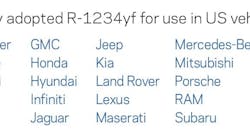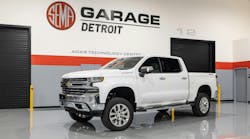Last August, the Obama administration announced it would increase fuel-economy standards to 54.5 mpg for cars and light-duty trucks by 2025. But six long-held fuel-economy myths prevent better efficiency with current automotive technology.
Only small cars are economical: Not so. Newer, standard-size vehicles have advanced technologies such as hybrid drive trains, diesel engines, turbochargers and low-rolling resistance tires, allowing them to compete on the fuel-efficiency charts.
Manual transmissions save gas: Manual, five-speed transmissions have been superior to automatic transmissions on gas mileage but largely because automatics with five speeds were rare, meaning the standard was four speeds, said Dan Edmunds, director of vehicle testing for Edmunds.com.
"The gap has narrowed to the point it's a toss-up between the two," he said. "EPA ratings for them are the same."
Automatic-transmission technology advancements have given automatics more gears to cut down on wasted fuel. New classes of automatics -- automatic manual transmissions, or AMTs -- combine the best features of both, with a potential 7 percent fuel-efficiency improvement, says FuelEconomy.gov, a source of government fuel-economy information.
Old vehicles gulp gas: Despite this common misconception, gas mileage generally improves over the first several years of ownership during the break-in period -- about the first 5,000 miles, says FuelEconomy.gov.
Replacing air filters saves gas: Replacing air filters on modern engines will not improve fuel economy. Replacing them would give fuel economy a kick if the vehicles had old engines with carburetors, but FuelEconomy.gov says this is not so with fuel-injected engines.
However, replacing clogged air filters improves acceleration time up to 11 percent, according to a new study by the Oak Ridge National Laboratory.
Premium fuel boosts fuel economy: Putting premium fuel in vehicles not specifically engineered for it will not give your gas mileage a boost. It's just a waste of money, said Tony Molla with the National Institute for Automotive Service Excellence in Leesburg, Va. Premium costs 15 to 20 cents more per gallon, adding up to $100 per year, says the Federal Trade Commission.
"Using a higher-octane fuel than recommended will have no effect on performance or fuel economy," Molla said.
Idling better than restarting: "Idling uses more fuel than stopping and restarting engines, and it's not even close," Edmunds said. "This is why stop-start technology is the coming thing."
Start-stop technology shuts off the engine when the vehicle is at rest -- such as at traffic lights -- and restarts it when the gas pedal is pushed. The technology has become a staple on hybrid cars.
"It's probably a fourth of their mpg magic -- maybe more," Edmunds said.
This doesn't mean you should manually turn off your vehicle at stoplights, because that is an obvious safety issue, Edmunds said. Also, normal starters without start-stop technology were designed for only a handful of starts per day, and ignition switches can wear out, as well.
If you're stopping more than five minutes, turn off the engine to save fuel.
"Better choices in fuel efficiency can save consumers hundreds, even thousands of dollars each year," said Bob Boundy, a researcher with the National Transportation Research Center at Oak Ridge National Laboratory.
"Compare the fuel economy of vehicles that meet all of your needs," he said, "You can save thousands of dollars over the life of the vehicle without compromising on size, performance, safety or quality."
Size doesn't matter: You don't have to squeeze into a subcompact car to visit the pump less often. Although it seems logical, "smaller cars are not always the most energy-efficient," Boundy said.
Size simply doesn't matter as much anymore -- a lot of what makes cars fuel-efficient is under the hood, in the materials it's made from or the way its body is designed.
Maintenance: The key phrase is "properly maintained engine." Regular maintenance will keep your engine running at peak efficiency, said Tony Molla with the National Institute for Automotive Service Excellence in Leesburg, Va. This means you should replace parts such as spark plugs before problems occur, etc.
Pay attention to the maintenance schedule in your owner's manual. Some garages promote overly aggressive air-filter replacement schedules, which is an unnecessary cost, Boundy says. An air filter costs $10 to $15. If you add labor costs, it could boost the cost by $19 to $60, according to Edmunds.com.
"Regular maintenance is the best investment you can make to keep your vehicle running efficiently and reliably over the long term," Molla said. "Barring normal wear of internal engine parts at very high mileage, there is no reason why a properly maintained engine won't deliver the same fuel economy over its operating life."
Fixing serious problems such as faulty oxygen sensors improves mileage 40 percent, says FuelEconomy.gov.

